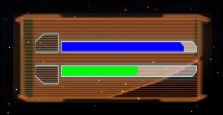Now let's move on to building our UI. For this example, we will build a simple health chart for our fighter to track the shield and hull strength of our craft, as shown in the following screenshot:

A top slider bar in blue for shields and a green bottom slider for health
Using our assets, let's throw this little gem together.
Tip
As a big tip, when you are working on just building UI elements and with positioning on a UI Canvas, it's best to switch to 2D mode (using the 2D button at the top of the scene view). It just makes things a lot easier with the UI.
When you have finished working on the UI, feel free to flip back into 3D mode (tap the 2D button again) to continue working with a 3D scene.
Granted, if you are creating a 2D game, you may never leave the 2D mode.
Firstly, add a new Canvas to the scene using Create | UI | Canvas from the project Hierarchy or GameObject | UI | Canvas from the menu and then rename it to ScreenSpaceCameraCanvas...



